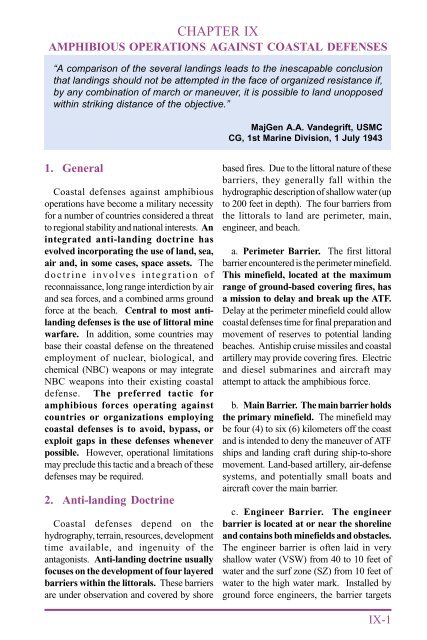Joint Doctrine for Amphibious Operations - Historic Naval Ships ...
Joint Doctrine for Amphibious Operations - Historic Naval Ships ...
Joint Doctrine for Amphibious Operations - Historic Naval Ships ...
- No tags were found...
Create successful ePaper yourself
Turn your PDF publications into a flip-book with our unique Google optimized e-Paper software.
CHAPTER IXAMPHIBIOUS OPERATIONS AGAINST COASTAL DEFENSES“A comparison of the several landings leads to the inescapable conclusionthat landings should not be attempted in the face of organized resistance if,by any combination of march or maneuver, it is possible to land unopposedwithin striking distance of the objective.”MajGen A.A. Vandegrift, USMCCG, 1st Marine Division, 1 July 19431. GeneralCoastal defenses against amphibiousoperations have become a military necessity<strong>for</strong> a number of countries considered a threatto regional stability and national interests. Anintegrated anti-landing doctrine hasevolved incorporating the use of land, sea,air and, in some cases, space assets. Thedoctrine involves integration ofreconnaissance, long range interdiction by airand sea <strong>for</strong>ces, and a combined arms ground<strong>for</strong>ce at the beach. Central to most antilandingdefenses is the use of littoral minewarfare. In addition, some countries maybase their coastal defense on the threatenedemployment of nuclear, biological, andchemical (NBC) weapons or may integrateNBC weapons into their existing coastaldefense. The preferred tactic <strong>for</strong>amphibious <strong>for</strong>ces operating againstcountries or organizations employingcoastal defenses is to avoid, bypass, orexploit gaps in these defenses wheneverpossible. However, operational limitationsmay preclude this tactic and a breach of thesedefenses may be required.2. Anti-landing <strong>Doctrine</strong>Coastal defenses depend on thehydrography, terrain, resources, developmenttime available, and ingenuity of theantagonists. Anti-landing doctrine usuallyfocuses on the development of four layeredbarriers within the littorals. These barriersare under observation and covered by shorebased fires. Due to the littoral nature of thesebarriers, they generally fall within thehydrographic description of shallow water (upto 200 feet in depth). The four barriers fromthe littorals to land are perimeter, main,engineer, and beach.a. Perimeter Barrier. The first littoralbarrier encountered is the perimeter minefield.This minefield, located at the maximumrange of ground-based covering fires, hasa mission to delay and break up the ATF.Delay at the perimeter minefield could allowcoastal defenses time <strong>for</strong> final preparation andmovement of reserves to potential landingbeaches. Antiship cruise missiles and coastalartillery may provide covering fires. Electricand diesel submarines and aircraft mayattempt to attack the amphibious <strong>for</strong>ce.b. Main Barrier. The main barrier holdsthe primary minefield. The minefield maybe four (4) to six (6) kilometers off the coastand is intended to deny the maneuver of ATFships and landing craft during ship-to-shoremovement. Land-based artillery, air-defensesystems, and potentially small boats andaircraft cover the main barrier.c. Engineer Barrier. The engineerbarrier is located at or near the shorelineand contains both minefields and obstacles.The engineer barrier is often laid in veryshallow water (VSW) from 40 to 10 feet ofwater and the surf zone (SZ) from 10 feet ofwater to the high water mark. Installed byground <strong>for</strong>ce engineers, the barrier targetsIX-1
















